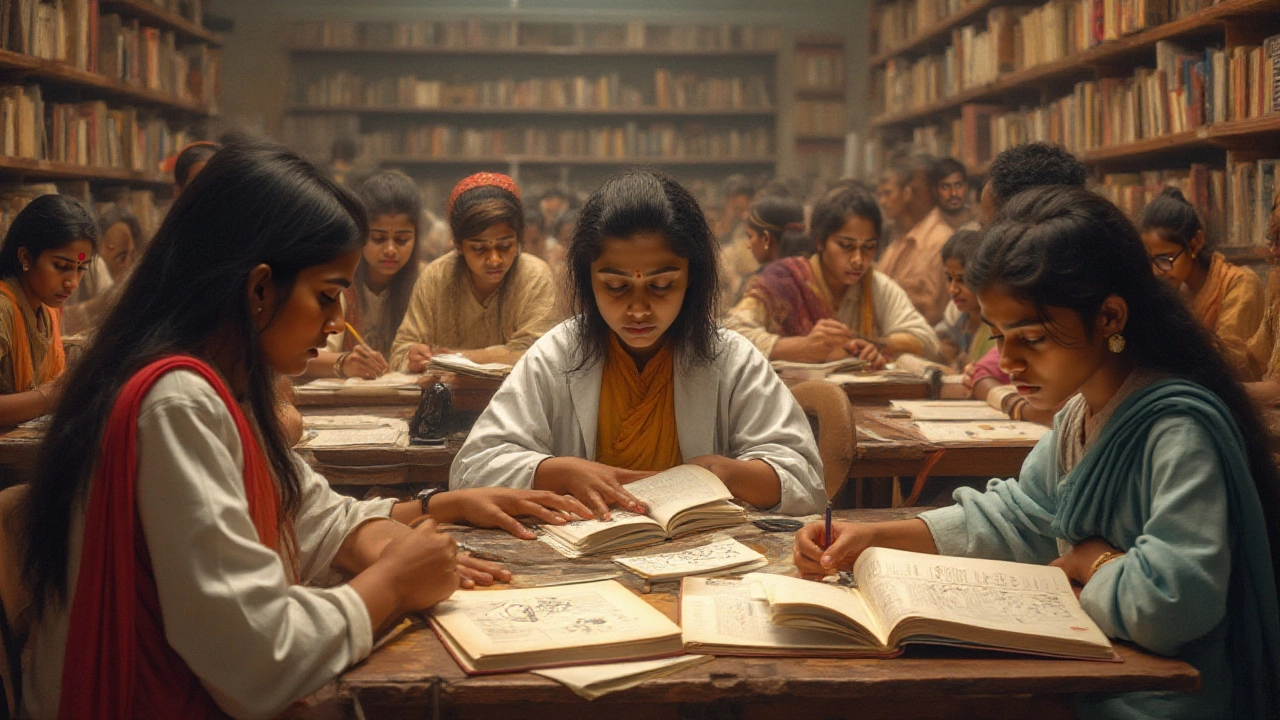
Picture this: a sleepless high school senior, textbooks piled up to the ceiling, bags under their eyes, parents pacing outside the door, and the weight of a nation's competition sitting right on their shoulders. That’s no rare scene across India every spring, as lakhs of students push themselves beyond their mental and physical limits for that one shot at getting into the country’s toughest courses. What exactly is the hardest course in India? Ask a dozen students, and you’ll likely get a dozen different answers. But dive a little deeper into ordinary colleges and elite institutes, and patterns start to emerge—some routes are almost legendary in their reputation for breaking the toughest and the brightest.
What Makes a Course “Hard” in India?
Not every difficult class is built the same. Some are notorious for their mountains of material, while others pile on insane competition or pressure. In India, difficulty isn’t just about late-night study sessions; it’s woven into the entrance exams, the selection ratios, and even the after-college stakes. For instance, the Joint Entrance Examination (IIT JEE) can see more than 18 lakh applicants every year, but only about 16,000 make it into one of the coveted IITs—that’s less than 1% making the cut. It’s a stew of tough exams, overwhelming syllabi, brutal time crunches, and, let’s face it, some serious societal expectations.
Certain streams—think engineering, medicine, chartered accountancy—are famous (or infamous?) for pushing students to their absolute limits. Each has its own horror stories: periodic 16-hour study days, mock test after mock test, and the dreaded wait for results. Even beyond these classic tracks, there are newer, niche domains fresh off the radar—law with its Common Law Admission Test (CLAT), design with NID and NIFT, or even postgraduate routes like the UPSC civil services exam, lining up lakhs of hopefuls for just a handful of seats.
So what puts a course on this “hardest” list? It usually comes down to a few core factors:
- Entrance barrier: Super-low acceptance rates.
- Sheer syllabus volume: Some courses supersize their curriculum, fitting years of material into months.
- Exam format: Lengthy papers, negative marking, interviews, aptitude and attitude tests.
- Cutthroat competition: Pressure cooker situations, where a single mistake can cost a year.
- Societal/personal expectations: Families, friends, and communities that set sky-high stakes.
And it’s not just teenagers battling through; even adult professionals who take up exams like the Chartered Accountant (CA) face famously low pass rates—single digits, even after multiple attempts.
IITs, Medicine & Chartered Accountancy: Facing the Giants
When most Indians talk about the “hardest” coursework, three names pop up again and again—engineering at IITs, MBBS for aspiring doctors, and Chartered Accountancy (CA). Each one is like a rite of passage, an Everest only a select few ever summit.
Start with IIT. The stakes begin with the Joint Entrance Examination (IIT JEE), a two-stage process (JEE Main followed by JEE Advanced). While lakhs appear for the JEE Main, the JEE Advanced shrinks the pool drastically. In 2024, the JEE Advanced saw around 1.8 lakh candidates competing for about 16,500 seats. Here’s a breakdown in a quick table:
| Course | Applicants (2024) | Seats | Acceptance Rate |
|---|---|---|---|
| IIT B.Tech (JEE Advanced) | 1,80,000 | 16,500 | ~ 0.9% |
| MBBS (NEET-UG) | 24,00,000 | 1,10,000 | ~ 4.6% |
| CA (Final Exam) | Numbers vary (multiple attempts) | 3,00,000+ active CAs | ~ 5-10% pass rate |
Engineering students slog through physics problems that would make adults sweat, chemistry marathons, and math questions that sometimes seem specifically designed to trip you up. Then, four (or more) years at an IIT aren’t any easier. The workload is heavy, with professors setting the academic bar at Olympic heights and competition turning friends into frenemies around exam time.
Switch gears to medicine. NEET-UG (National Eligibility cum Entrance Test) for MBBS is brutal—over 24 lakh students chasing just over 1 lakh seats, and most of the best seats are in government colleges. The syllabus isn’t light—imagine remembering every artery, every bone, every weird disease. And after a student wins a seat, the next 5 or more years are packed with hours of practicals, ward rounds, sleepless nights, and exams that never seem to end. The stress doesn’t let up after graduation—PG entrances like NEET-PG and specialized fields ask even more.
Then there’s Chartered Accountancy, an infamously tough professional route. Clearing all CA exams—with its grueling multi-stage process (Foundation, Intermediate, and Final)—takes years. You might know someone who’s spent half a decade just prepping for that last Final hurdle, slogging through complex tax law changes and monstrous audit cases. Pass rates for each level? Less than 10% each time, even for repeat test-takers. It’s like running a marathon where the finish line keeps moving.
I asked my own cousins who’ve cracked these giants—what’s the worst part? One said the constant comparison with peers. Another mentioned the mental fatigue, “You can’t even look at simple math the same way after years of JEE prep.” The world wants the toppers—so even being above average sometimes doesn’t cut it.

Lesser-Known Courses That Pack A Punch
The spotlight usually shines brightest on IITs, doctors, and CAs, but there’s a whole world of courses in India that sneak up with intense difficulty. Law is one such field. Getting into the top-tier National Law Universities (NLUs) means cracking the CLAT, where about 50,000 candidates fight for less than 2,000 seats across all NLUs. But the challenge doesn’t stop after clearing CLAT—life inside an NLU is a shark tank. Students juggle mock courts, back-to-back assignments, public speaking, internships, and an exam schedule that could make grownups dizzy. Marks, ranking, and internship opportunities can legit make or break a career before it even begins.
Ever met a designer fresh out of the National Institute of Design (NID) or National Institute of Fashion Technology (NIFT)? They’re artists, but also skilled technicians, thinkers, and hustlers. Entrance exams here are about logic, spatial reasoning, creativity pressing against the clock—and that’s just round one. Interviews, hands-on tests, and portfolio reviews are brutal, sometimes subjective enough to trip up even the most confident students.
Let’s not forget about science and research. The Indian Institutes of Science Education and Research (IISERs) have their own grueling selection process: the IISER Aptitude Test. What starts as a love for chemistry in school can spiral into marathon study weeks, and the kind of research work that demands both genius and stamina. Research programs in India are no walk in the park. Working under a thesis advisor for a PhD can mean years of uncertainty—projects go nowhere, funding dries up, and “publish or perish” becomes a mantra. A lot of students deal with low pay and minimal work-life balance throughout.
And then there’s the UPSC Civil Services Exam. While not technically a “course,” it’s a challenge that eats up the lives of lakhs every year. One main exam plus the personality test, optional subject choices, current affairs, and essays. The total time from start to finish can run more than a year, and “failure” is common at every stage. Acceptance rates for the Indian Administrative Service (IAS)? Usually less than 1%—sometimes just a few hundred successful candidates. The syllabus runs so wide that even history scholars feel overwhelmed.
Curiously, some of the vocational and trade courses also surprise people. Industrial Training Institutes (ITIs) have specializations like advanced machining, tool crafting, or electrical work that require hours of hands-on practice, rigorous safety adherence, and exams that are just as unforgiving as the academic ones. Their impact is massive, though—skilled people from these backgrounds build and fix a lot that keeps India running.
Tips to Survive & Succeed in India’s Toughest Courses
If you or someone in your family’s eyeing one of these “hardest” routes, don’t start with just extra tuition. Mindset and planning are everything. Here are some tried-and-true ways to not just survive, but sometimes even thrive:
- Break your syllabus into small, doable chunks. The mountain’s less terrifying up close.
- Make a realistic timeline—and leave buffer days for when things (inevitably) go wrong.
- For competitive exams like IIT JEE or NEET, practice old papers until they feel like muscle memory. Mock tests show not just what you don’t know—but also how you handle pressure.
- Don’t ignore health. A tired body means a tired mind. Even a quick walk or 10-minute nap can sometimes shake off the worst block.
- Talk it out—whether it’s with your friends, an older cousin, or even your parents. Sometimes, hearing that others are struggling too helps you realize you’re not alone (and you’re not doomed).
- Keep one non-academic activity—a favorite TV show, a music session, or just silly meme scrolling. Don’t let the stress completely take over.
- Make your mistakes early. It’s better to trip up on a mock test than the real thing.
- If you fail, remember, most successful people failed more times than they care to admit. And if you need a break, take it. Burnout isn’t heroic, it just makes the climb longer.
- Lastly, remember that these “hardest” courses are hard because they’re worth doing—but they’re not the only way to succeed or prove your worth. There are thousands of careers (and millions of ways to build a life). Maybe the most important thing is figuring out what you’re aiming for in the first place.
Here’s a wild fact: the World Health Organization once flagged test anxiety and burnout from competitive Indian exams as a serious health issue for the country’s youth. If you’re reading this and thinking, “Is it all worth it?”—you’re far from alone. It can feel like an endless chase, but there’s always life, and a future, waiting on the other side of even the toughest courses. You just get to decide what winning looks like for you.

